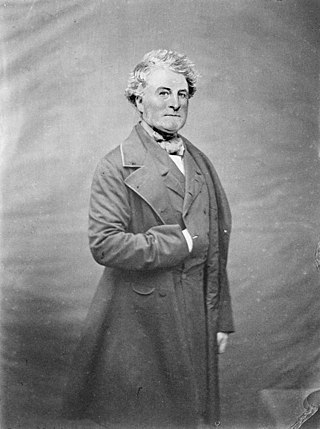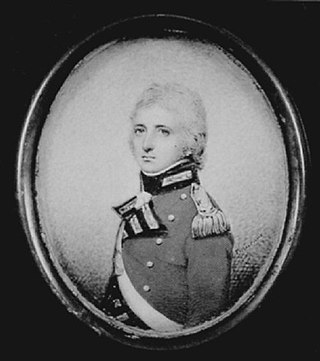Related Research Articles

Barrimore Matthew "Barry" St. Leger was a British Army officer. St. Leger was active in the Saratoga Campaign, commanding an invasion force that unsuccessfully besieged Fort Stanwix. St. Leger remained on the frontier for the duration of the war; after its conclusion, he served briefly as commander of British forces in Quebec.

Field Marshal Sir Robert Rich, 4th Baronet was a British cavalry officer. As a junior officer he fought at the Battle of Schellenberg and at the Battle of Blenheim during the War of the Spanish Succession. He was then asked to raise a regiment to combat the threat from the Jacobite rising of 1715. He also served with the Pragmatic Army under the Earl of Stair at the Battle of Dettingen during the War of the Austrian Succession. As a Member of Parliament he represented three different constituencies but never attained political office.

Field Marshal Studholme Hodgson was a British Army officer who served during the 18th century. After serving as an Aide-de-Camp to the Duke of Cumberland at the Battle of Fontenoy during the War of the Austrian Succession and at the Battle of Culloden during the Jacobite Rebellion, he became correspondent to William Barrington, the Secretary at War, during the French and Indian War. He went on to command the British expedition which captured Belle Île in June 1761 during the Seven Years' War so enabling the British Government to use the island as a bargaining piece during the negotiations leading up to the Treaty of Paris in 1763.
Listed in the table below are the insignia—emblems of authority—of the British Army. Badges for field officers were introduced in 1810 and the insignia was moved to the epaulettes in 1880. On ceremonial or parade uniforms these ranks continue to be worn on the epaulettes, either as cloth slides or as metal clips, although on the modern 'working dress' they are usually worn as a cloth slide on the chest. Although these insignia apply across the British Army there is variation in the precise design and colours used and it can take some time to become familiar with them all.

General Sir Charles Colville was a British Army officer who served during the Napoleonic Wars. He was an ensign in 1781. He served in the West Indies from 1791 to 1797 and while serving there was promoted to lieutenant-colonel (1796). He helped to suppress the Irish Rebellion of 1798. He was in Egypt in 1801 and fought at Martinique in 1809. He commanded brigade, and afterwards division, in the Peninsular War from 1810 until 1814. During the Waterloo Campaign of 1815 he commanded a division in Belgium and the same year was made a K.C.B. In 1819 he was promoted to lieutenant-general and served as commander-in-chief at Bombay from 1819 until 1825. He was governor of Mauritius from 1828 until 1834. He was promoted to general in 1837.

Lieutenant-General William Keppel was a British Army officer and Member of Parliament.
Field Marshal Lord Frederick Cavendish was a British Army officer and Whig politician. After serving as an aide-de-camp to the Duke of Cumberland in Germany during the early stages of the Seven Years' War, he served under Charles Spencer, 3rd Duke of Marlborough in the raid on St Malo and then took part in the raid on Cherbourg. Cavendish commanded the rear-guard during the re-embarkation following the disastrous battle of Saint Cast and was taken prisoner. After his release, Prince Ferdinand of Brunswick gave him command of a brigade of chasseurs which he led to victory at the Battle of Wilhelmsthal in June 1762.

Lieutenant-General Daniel Webb was a British Army officer best known for his actions during the French and Indian War. At the age of twenty, he purchased a commission in the British Army at the rank of ensign on 20 March 1720. In 1742, Webb was promoted to the rank of major while serving in the 8th Horse, and he fought at the battle of Dettingen on 27 June 1743. Three years later in April 1745, Webb was again promoted to the rank of lieutenant colonel and on 11 May of that year fought at the battle of Fontenoy. In 1755, he was made colonel of the 48th Regiment of Foot. After the outbreak of the French and Indian War in 1754, Webb sailed to North America as a subordinate of Lord Loudoun.

General John Howard, 15th Earl of Suffolk, 8th Earl of Berkshire, FSA was a British Army officer and peer.
Major-General Welbore Ellis Doyle was the third Military Governor of British Ceylon. He was appointed on 1 January 1797 and was Governor until 2 July 1797. He was succeeded by Peter Bonnevaux.

General Sir Richard England, was a British Army officer, born at Detroit, which was then part of Upper Canada. During the Napoleonic Wars he saw active service in Walcheren, Sicily, and at Waterloo, before commanding regiments and divisions in the Crimean War and in India.

Brigadier John Pennycuick CB, KH was an officer in the British Army who served in Java, Burma, Aden, Afghanistan and India. He was born in Soilzarie in Perthshire and was killed at the Battle of Chillianwalla in the Second Anglo-Sikh War.

Major-General Stephen Cornwallis was a career British Army officer and politician who sat in the House of Commons from 1727 to 1743.
Major-General John Grey was an officer of the British Army.
Lieutenant-General William Barrell was an officer of the British Army.
Lieutenant-General John Folliot or Folliott was an officer of the British Army.
Lieutenant-General Robert Napier was an officer of the British Army.
General Gordon Forbes was a senior officer in the British Army.
William Rufane was a British soldier who fought in the Seven Years' War, was governor of Martinique in 1762–63 and rose to the rank of lieutenant general.

General Gerard Gosselin was a British Army officer of the eighteenth and nineteenth centuries. After a short stint in the Marines, he joined the British Army in 1787 in the 34th Regiment of Foot. Having been promoted to lieutenant in 1791 he transferred to the 2nd Regiment of Life Guards in the same year, where he initially served as adjutant. Gosselin was promoted to captain in 1794 and almost immediately purchased his majority as well, transferring to the 130th Regiment of Foot. He travelled with this regiment to Jamaica where they served as garrison troops until returning home in 1796.